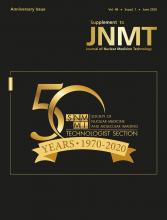One of mankind’s greatest endeavors is to ease suffering and cure disease, but how do you treat what you cannot see? Through observation and imagination, the origins of disease were theorized and then visualized with the invention of the microscope. As the unseen world became visible, more questions arose, and more details were needed. This led to the discovery of the cell. As understanding grew of life’s basic building block, many dreamt of the ability to watch our hidden biology in real time. One hundred twenty-five years ago, a new weapon in this quest was discovered. Wilhelm Röntgen’s discovery of the x-ray, followed shortly by Marie Curie’s work with radium and the theory of radioactivity, brought to the fight powerful new tools to visualize and treat disease.
These discoveries led to additional medical uses for radioisotopes. In 1941, Saul Hertz showed how radioactive iodine could be used to treat thyroid diseases (1). Then, in 1952, Hal Anger developed the sodium iodide (NaI(Tl)) camera, which allows the practical imaging of radionuclides (2). Nuclear medicine came to life by combining these 2 discoveries. Now that a disease process could be visualized and treated using radioisotopes, who would guide medicine in this new era?
During this time, Norman “Jeff” Holter realized that for nuclear medicine to flourish it would need its own professional society (3,4). In short order, the Society of Nuclear Medicine was created. In 1970, only 50 y ago, a visionary group expanded the Society of Nuclear Medicine by adding a Technologist Section (SNMMI-TS). These pioneers understood that in order to realize the full potential of nuclear medicine, quality technologists would be needed. To be successful, technologists would need to build a foundation of knowledge in the sciences. Then, they would have to learn to translate this technology for each patient. This would require them to develop the heart of a teacher, one filled with compassion, so that they could guide others. As technologists work in these areas, they will be able to advance the future of nuclear medicine.
Now it is 2020. What will the next 50 y of nuclear medicine look like? To increase this vision, we need to look at the exciting advancements taking place in the field of nuclear medicine. Our field is growing on many fronts. First, new radiopharmaceuticals are being approved, and new methods are being developed to provide them. Next, scanner technology is entering a new era in order to better image these agents. Finally, computing power is increasing the information that can be extracted from these images. The future of nuclear medicine is strong.
The strength of nuclear medicine comes from the use of radiotracers. Many processes in the body can be studied this way (5). As our understanding of these mechanisms improve, so do the opportunities for nuclear medicine to lead the way in diagnosing and treating disease. Access to these agents is expanding through drug approval and clinical reimbursement. Additionally, isotope production methods are opening new avenues to access them. Low enriched uranium can now be processed to increase supply (6). Cyclotrons are becoming more efficient and even miniaturized to reduce cost and improve access (7). Radiotracers will continue to help us measure the unseen.
Nuclear medicine is leveraging the potential applications of new radiotracers by improving their detection. Radiotracer imaging is one of the most sensitive in vivo methods available (8), yet the overall sensitivity is <1% (9). Fortunately, new scintillators are opening our horizons. From cadmium zinc telluride (CZT) to lutetium oxyorthosilicate (LSO), scintillation detector materials are improving (10,11). Opportunities abound for the development of even better and brighter scintillators (12).
Imaging resolution relies on detectors that can match these scintillation crystal improvements. Digital silicon photomultipliers are meeting this need with their size and accuracy (13). PET is leveraging this combination of improved scintillators and digital detectors to bring better resolution than ever through time of flight (TOF) imaging (14). The potential for advancements in TOF technology will speed the growth of nuclear medicine (12). Additionally, clinical scanners are getting faster by expanding their axial field of view or even reducing lost imaging time with continuous bed motion (15). Finally new reconstruction techniques and software packages are providing better images with more information (13). When you leverage all of these advancements together, unparalleled imaging is possible.
A new total-body PET scanner has achieved an approximately 40 fold increase in sensitivity (9). This increased sensitivity allows many improvements. Image quality is boosted. Scan times can be reduced so far that a total-body PET scan can occur in 15–30 s. Additionally, the range of physiologic data that can be measured is being expanded. This means that an 18F-FDG PET scan could be acquired at 10 h or even a PET scan using 89Zr could take place up to 30 d after injection. This technology could even make it possible to study multiple disease parameters in one imaging session using multiple radiotracers injected in sequence. These improvements pave the way to a new understanding of the complex physiologic mechanisms in the body through dynamic imaging and kinetic modeling. Even more, the reduction in radiation dose could allow for imaging in new populations and new disease states. A total-body PET scan could give less radiation dose than a screening mammogram.
All of these advancements place nuclear medicine at the forefront of precision medicine. The combination of diagnosis and treatment using radioisotopes has been successful (16). This approach shows promise to expand to other disease states (17,18). Nuclear medicine is the key to unlocking the future of personalized medicine.
In the next 50 y, Technologists will be needed more than ever to come together as professionals. As they work with their physician partners and the SNMMI-TS to stay current, they will be able to guide medicine. Then, the world will see what nuclear medicine has to offer and the pivotal role that it will play in the human journey to eradicate disease.










